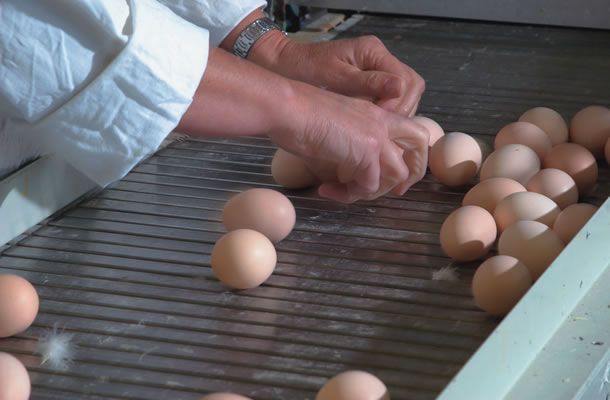Care of the egg: from nest to farm store
Tags: Egg handling | Whitepaper
, August 27 2010

healthy, well managed breeder flock, receiving a balanced feed ration, will produce good quality hatching eggs. At the moment an egg is laid, it contains an embryo of 30,000 - 60,000 cells. At that point in time, each cell is already programmed for its future function. With the best of care, the hatching potential held in this delicate embryonic structure will be fully realised. But get it wrong - and much can go amiss between nest and farm store.
Although the exact level of the so-called ‘physiological zero’ is debated by hatchery specialists and researchers, there is a general consensus that embryonic development, which starts in the hen’s body, will continue as long as internal egg temperature is more than 25 - 27 ˚C.
Ideally, eggs should be cooled down uniformly and gradually from body temperature to between 18 and 25 ˚C in 6 - 8 hours. However the rate of cooling depends on several factors. Nest type in relation to frequency of egg collection plays an important role. Eggs produced in manually collected litter nests cool down very slowly to environmental temperature, due to the insulation provided by the surrounding nest litter. Since nest boxes are shared between 5 - 7 hens, warmth is brought to partially cooled-down eggs again every time another hen enters the nest. It is only once eggs are collected, that they are able to cool down properly. In automatic nests, the eggs roll away to an egg transport belt soon after being laid, which exposes all the eggs to a similar environmental temperature.
Egg temperature at the moment of collection will vary from egg to egg, with some still holding a temperature of more than 25 ˚C. In this case, further cooling is required. A newly produced egg, with a temperature close to that of the hen’s body (41 ˚C), will take much longer to cool down when placed at the centre of a pulp tray and covered by the next full tray, than an egg placed at the side of the pulp tray. Ensuring that there is an adequate supply of free circulating air over the trayed eggs will greatly assist in providing uniform cooling.
And there are further considerations when seeking to maintain the quality of the eggs after oviposition. For example, too many eggs in a nest leads to an increased incidence of hair cracks, with a negative effect on hatchery results. Hair cracks can also result from over-filling the egg transport belt, which causes the newly laid eggs to bump against each other. Nest hygiene, too, is important for the avoidance of contamination. Floor eggs are a hotbed of infection in the hatchery, affecting both hatchability and chick quality, with further reaching effects also extending to increased first week mortality and reduced performance in the receiving farms.
Advice
- Handle eggs with care at all times.
- Avoid shocks and jolts in handling. Remember that not only is the shell fragile, but also that inside exists an equally fragile embryonic structure!
- Collect eggs from manual litter nests at least 4 times/day.
- Collect eggs from automatic roll away nests 2 - 3 times/day, ensuring that temperature on the egg transport belt is 18 - 22 ˚C.
- Maintain a temperature of 18 - 22 ˚C in the egg collection room, to prevent eggs cooling down too quickly or warming up again.
- Maintain good nest hygiene at all times. Close the nests during the night, and ensure that they are opened again before the start of egg production the next morning.
- Avoid floor eggs, which should not be incubated, by good management practice that starts from the rearing period.
- Allow sufficient airflow over the eggs after collection to ensure uniform cooling. This is best achieved by collecting eggs on setter trays. Eggs should never be packed in cardboard boxes before they have cooled down.
- Further avoid hair cracks by using well designed trays, without sharp edges, that adequately support the eggs.
- Do not use sloppy trays and avoid overstacking.